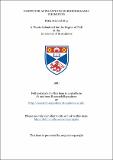Files in this item
Computer applications in bioinorganic chemistry
Item metadata
| dc.contributor.advisor | Williams, David R. | |
| dc.contributor.author | May, Peter Michael | |
| dc.coverage.spatial | 470 p. | en_US |
| dc.date.accessioned | 2018-06-26T08:13:05Z | |
| dc.date.available | 2018-06-26T08:13:05Z | |
| dc.date.issued | 1981 | |
| dc.identifier.uri | https://hdl.handle.net/10023/14569 | |
| dc.description.abstract | Nowadays, computers play an indispensable role in the determination of metal-ligand formation constants and in their application to various situations of analytical, industrial or biological interest. The development of programs and simulation techniques to meet some current problems in bioinorganic chemistry constitutes the broad objective of the present research. Consideration is given to the thermodynamic calculation of complex species concentrations in biological fluids. New methods of solving the mathematical relationships for metal-ligand solution equilibria, particularly in the simulation of large multicomponent systems, are investigated. The ways in which computer simulations are involved in the determination of formation constants are discussed. Principles are developed and applied to problems concerning (i) the calibration of glass electrodes and (ii) the choice of complex species to describe metal-ligand systems under experimental investigation. The function of transition elements in biological systems is briefly reviewed. Emphasis is given to the significance of low-molecular-weight complexes and how a knowledge of their in vivo behaviour can affect bioinorganic drug design. The relationship between copper and rheumatoid arthritis and the importance of equilibria in the regulation of iron metabolism are treated in some detail. New simulation techniques are developed for blood plasma. The results successfully rationalise many bioinorganic phenomena. In particular, the relative ability of a series of chelating agents to compete with proteins for metal ions in plasma is correlated with the urinary excretion of trace elements that they cause. Further simulations extend the approach to other biofluids and to medical solutions intended for intravenous infusion. | en_US |
| dc.language.iso | en | en_US |
| dc.publisher | University of St Andrews | |
| dc.subject.lcc | QP519.7M2 | |
| dc.subject.lcsh | Biochemistry--Technique | en |
| dc.title | Computer applications in bioinorganic chemistry | en_US |
| dc.type | Thesis | en_US |
| dc.contributor.sponsor | South Africa. Council for Scientific and Industrial Research (CSIR) | en_US |
| dc.type.qualificationlevel | Doctoral | en_US |
| dc.type.qualificationname | PhD Doctor of Philosophy | en_US |
| dc.publisher.institution | The University of St Andrews | en_US |
This item appears in the following Collection(s)
Items in the St Andrews Research Repository are protected by copyright, with all rights reserved, unless otherwise indicated.

